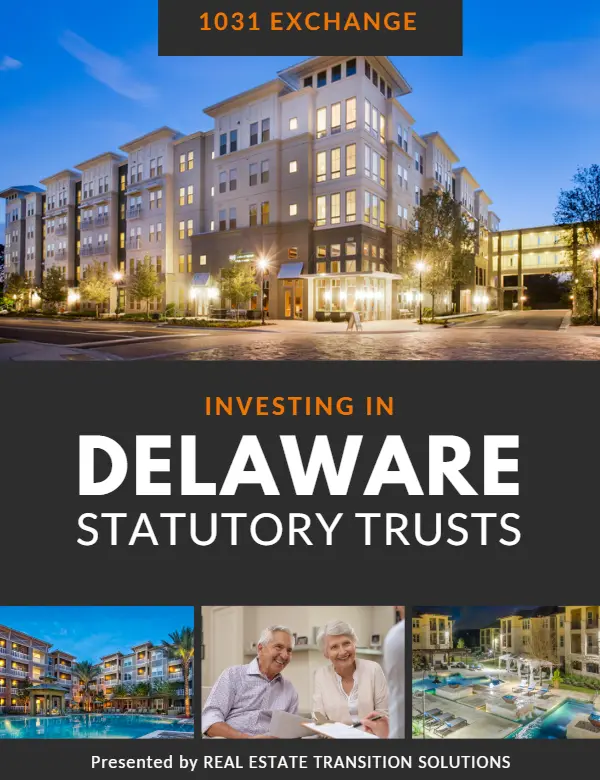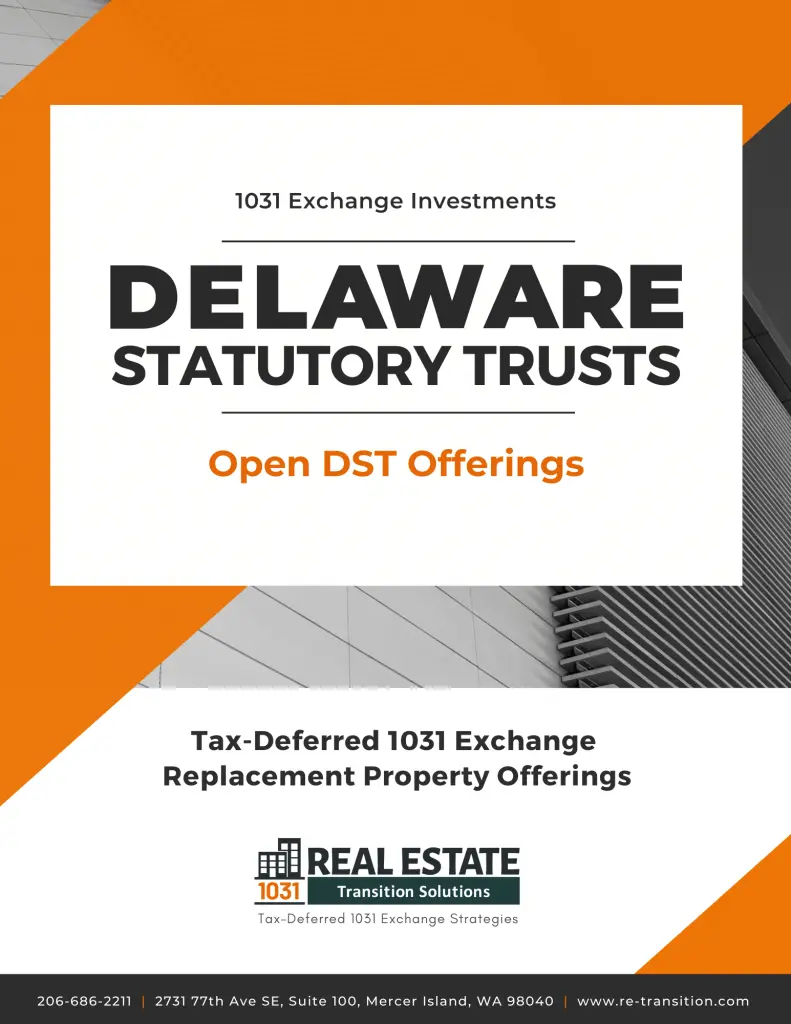1031 Exchange Examples
1031 Exchange Example: Howard & Lee Anne’s Apartment Building
Reduce Taxable Income & Increase Depreciation
One of the tax benefits associated with owning investment property is being able to deduct depreciation. However, an investment property that has been owned for several decades will eventually become fully depreciated and can no longer be deducted to help offset taxable income.
Let’s take a look at how Real Estate Transition Solutions helped Howard and Lee Anne lower their taxable income and increase their depreciation by performing a 1031 Exchange into Delaware Statutory Trust (DST) replacement property.

Meet Seattle Real Estate Investors Howard & Lee Anne
Howard and Lee Anne own a 10-unit apartment building in Seattle, which they acquired in 1992 for $850,000. In 2019, Howard and Lee Anne decided to retire and sell their apartment building, which was valued at $3,200,000 with a 3.4% return on equity, had no debt, and produced a net income of $110,000 per year. Howard and Lee Anne listed their property for sale and contacted Real Estate Transition Solutions to help them perform a 1031 Exchange.
Their Exchange Objectives:
Like most investment property owners, Howard and Lee Anne had multiple reasons for performing a 1031 Exchange. However, because their apartment building would be fully depreciated by June 30, 2019, their primary objective was to establish a new depreciation shelter in order to lower their annual taxable income.
Their Relinquished Property:
- Their 10-unit apartment building was purchased in 1992 for $850,000.
- Ninety percent (90%) of the value of the $850,000 purchase price was allocated to the physical structure ($765,000), and 10% was allocated to the value of the land ($85,000), which is not depreciable.
- No capitalized improvements were made to the property.
- Soon-to-expire depreciation allowed for Howard and Lee to benefit from $27,818 of annual depreciation for the last 27.5 years.
- By 2019, their apartment building was valued at $3,200,000, had no debt, and was producing a net income of $110,000 per year with a return on equity of 3.4%.
- The net sale proceeds are estimated at $3,008,000.
Calculating 1031 Exchange Tax-Deferral Savings
One of the first things we do when working with a client is to help them understand their gains tax liability and 1031 tax-deferral savings. Tax liability from the sale of investment real estate is not just about federal capital gains tax – it is the total aggregate amount of tax owed when an investment property is sold. Not only are investment property owners responsible for Federal Capital Gains Tax (15% – 20%), but investors may also have to pay State Capital Gains Tax (0-13.3%), Depreciation Recapture Tax (25%), and Net Investment Income Tax (3.8%). For Howard and Lee Anne, a 1031 Exchange helped them avoid paying $733,924 in gains tax.
-
Net Proceeds from Selling Property $3,008,000
Selling price less selling costs
-
(-) Original Tax Basis $850,000
Less original purchase price plus capital improvements
-
(=) Estimated Taxable Gains $2,158,000
Equals net sales proceeds less original tax basis
-
(=) Estimated Capital Gains Tax $513,604
Equals federal capital gains and net investment income tax plus state capital gains tax
-
(=) Depreciation Recapture Tax $220,320
Equals tax applied to accumulated depreciation
-
(=) Total Taxes Deferred $733,924
Our Exchange Strategy for Howard & Lee Anne
Depreciable basis can only be increased by the acquisition of a higher value investment property. Without contributing additional equity to a purchase, this can be accomplished by acquiring real estate that has a higher loan-to-value than the property to be sold and Exchanged (the relinquished property). Adding debt may not be possible for an owner who is retired and may not qualify for a loan on an investment property even if they own a substantial real estate portfolio.
However, any debt held in a DST is held at the trust level and is fully secured by the underlying real estate, as opposed to guaranteed by the owners of the property (“non-recourse”). Because the debt is held at the trust level, it does not appear on the balance sheet of the owners, but it does provide DST owners depreciation benefits.
By performing a 1031 Exchange into a Delaware Statutory Trust real estate, property owners are able to increase their leverage and thus their annual depreciation with low-cost non-recourse debt, leading to a greater portion of their rental income being sheltered from state and federal income tax.
Their 1031 Replacement Property Portfolio:
To lower Howard & Lee Anne’s taxable income, Real Estate Transition Solutions recommended a 1031 Exchange into a portfolio of management-free DST real estate designed to provide the potential for monthly income and increase their depreciation.
Real Estate Transition Solutions recommended a portfolio of 5 DST property offerings consisting of 31 properties, diversified among 10 different states, for their net sales proceeds of $3,008,000 (the sales price of the property, less closing costs). The portfolio included an allocation of:
- $1,008,000 to apartment buildings (3 DSTs)
- $1,000,000 to value-add apartment buildings (1 DST)
- $1,000,000 to a diversified portfolio of 24 single-tenant net-lease properties (1 DST)
The portfolio had a total loan-to-value of 55%. All the debt was 10-year fixed-rate debt that was non-recourse with interest rates ranging from 2.84% – 3.85%, depending on the offering. The $3,008,000 of exchange proceeds acquired $6,844,444 of replacement property and thus $3,764,444 of new basis for depreciation. Ninety percent (90%) of the new basis could be depreciated.
1031 Exchange Goals Achieved:
By performing a 1031 Exchange into DST real estate, Howard and Lee Anne were able to sell their investment property with full tax deferral while achieving their objectives – they eliminated active property management, improved the potential for stable monthly income, and increased depreciation to lower their taxable income.
Howard and Lee Anne’s portfolio of DST real estate produced $172,200 of annual income (a 5.59% return on equity). A 64% increase over their previous income. What’s more, the new depreciation attributed to an increased value of their portfolio – instead of zero depreciation after June 30, 2019, their portfolio produced $111,405 in annual depreciation. This means that while Howard and Lee Anne’s cash flow was 64% higher, their taxable income was only $60,795 – a decrease of 26%.
1031 Exchange Example: Walter & Maria’s Single Family Rental
Eliminate Landlord Duties & Increase Income Potential
Owning and managing rental property can be rewarding in many ways, especially with great tenants, a strong economy, and low unemployment rates. However, being a landlord can also be very stressful and challenging at times – repairs can be costly and evictions can take an emotional toll on everyone involved. Some landlords opt to hire third-party property management firms. Unfortunately, this approach can dilute needed cash flow which is why more landlords are opting to sell their rental property with a 1031 Exchange into Delaware Statutory Trust (DST) investment property.
Let’s take a look at how Real Estate Transition Solutions helped Walter & Maria retire from active property management by selling and performing a 1031 Exchange into Delaware Statutory Trust (DST) replacement property.

San Diego Landlords Walter & Maria
Walter and Maria own and manage a single-family rental home in San Diego, which they purchased in 1987 for $54,000. Although they enjoyed owning investment property, by 2020, Walter and Maria were ready to retire and wanted to live closer to their daughter and grandson. They worked with their realtor to get their property listed and reached out to Real Estate Transition Solutions to help them perform a 1031 Exchange into DST real estate.
Their Exchange Objectives:
Again, like most investment property owners, Walter and Maria had several objectives for their 1031 Exchange. However, their primary objective was to retire and live closer to their daughter and grandson, so their 1031 Exchange Advisor at Real Estate Transition Solutions recommended a portfolio of management-free DST replacement properties with a focus on generating stable, monthly income for Walter and Maria.
Their Relinquished Property:
- Single-family rental home located in San Diego, CA
- Purchased in 1987 for $54,000.
- The investment property is fully-depreciated
- Walter and Maria have no debt on the property
- By 2020, their investment property was valued at 700,000
- Their property generated a net annual rental income of $36,000.
- Net sale proceeds are estimated at $651,000
Calculating 1031 Exchange Tax-Deferral Savings:
-
Net Proceeds from Selling Property $651,000
Selling price less selling costs
-
(-) Original Tax Basis $74,000
Less original purchase price plus capital improvements
-
(=) Estimated Taxable Gains $577,000
Equals net sales proceeds less original tax basis
-
(=) Estimated Capital Gains Tax $198,467
Equals federal capital gains and net investment income tax plus state capital gains tax
-
(=) Depreciation Recapture Tax $15,885
Equals tax applied to accumulated depreciation
-
(=) Total Taxes Deferred $214,352
Our Exchange Strategy for Walter & Maria
Walter and Maria were ready to retire from their career as landlords and needed stable monthly income. Real Estate Transition Solutions recommended a 1031 Exchange into a portfolio of management-free DST real estate designed to provide the potential for stable, monthly income.
Their 1031 Replacement Property Portfolio:
Real Estate Transition Solutions worked with Walter and Maria to design a portfolio of 2 DST property offerings consisting of 31 properties, diversified among different states. The portfolio included an allocation of:
- Allocation of 60% Net Lease property and 40% multifamily property
- Weighted heavier towards Net Lease for greater income
- New depreciation shelter of 50%
- $390,000 diversified portfolio of 21 single-tenant net lease properties (1 DST)
- $261,000 in “Class A” multifamily property in Las Vegas, Nevada (1 DST)
1031 Exchange Goals Achieved:
By performing a 1031 Exchange into DST real estate, Walter and Maria were able to sell their investment property with full tax deferral, retire from active property management, and improve the potential for stable monthly income.
Disclaimer: Client portfolio example is hypothetical and for illustration purposes only. Potential cash flows, returns, and appreciation are not guaranteed and could be lower than anticipated. Tax rates may vary per state. Individual results will vary.

Features 28 pages with rules, tips, examples, and more.



